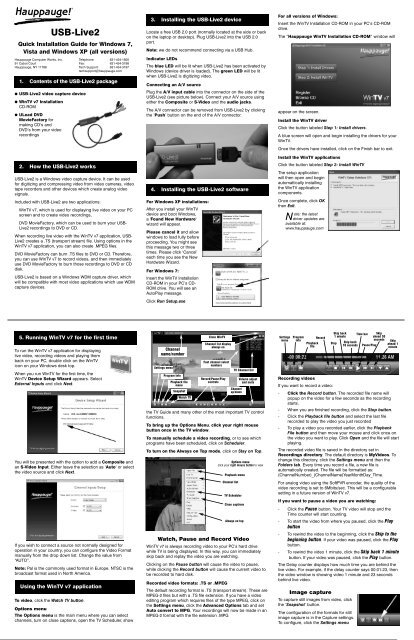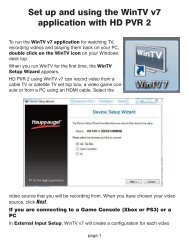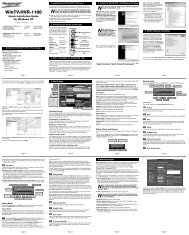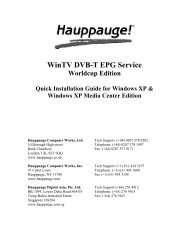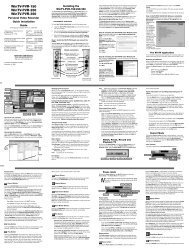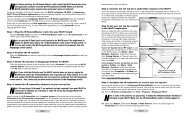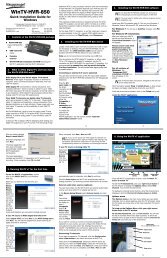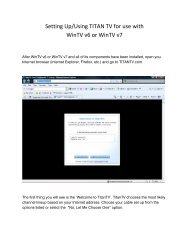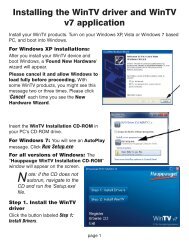USB-Live2
USB-Live2
USB-Live2
Create successful ePaper yourself
Turn your PDF publications into a flip-book with our unique Google optimized e-Paper software.
<strong>USB</strong>-<strong>Live2</strong><br />
Quick Installation Guide for Windows 7,<br />
Vista and Windows XP (all versions)<br />
Hauppauge Computer Works, Inc. Telephone: 631-434-1600<br />
91 Cabot Court Fax: 631-434-3198<br />
Hauppauge, NY 11788 Tech Support: 631-434-3197<br />
techsupport@hauppauge.com<br />
1. Contents of the <strong>USB</strong>-<strong>Live2</strong> package<br />
● <strong>USB</strong>-<strong>Live2</strong> video capture device<br />
● WinTV v7 Installation<br />
CD-ROM<br />
● ULead DVD<br />
MovieFactory for<br />
making CD’s and<br />
DVD’s from your video<br />
recordings<br />
2. How the <strong>USB</strong>-<strong>Live2</strong> works<br />
<strong>USB</strong>-<strong>Live2</strong> is a Windows video capture device. It can be used<br />
for digitizing and compressing video from video cameras, video<br />
tape recorders and other devices which create analog video<br />
signals.<br />
Included with <strong>USB</strong>-<strong>Live2</strong> are two applications:<br />
WinTV v7, which is used for displaying live video on your PC<br />
screen and to create video recordings,<br />
DVD MovieFactory, which can be used to burn your <strong>USB</strong>-<br />
<strong>Live2</strong> recordings to DVD or CD.<br />
When recording live video with the WinTV v7 application, <strong>USB</strong>-<br />
<strong>Live2</strong> creates a .TS (transport stream) file. Using options in the<br />
WinTV v7 application, you can also create .MPEG files.<br />
DVD MovieFactory can burn .TS files to DVD or CD. Therefore,<br />
you can use WinTV v7 to record videos, and then immediately<br />
use DVD MovieFactory to burn those recordings to DVD or CD<br />
disk.<br />
<strong>USB</strong>-<strong>Live2</strong> is based on a Windows WDM capture driver, which<br />
will be compatible with most video applications which use WDM<br />
capture devices.<br />
5. Running WinTV v7 for the first time<br />
To run the WinTV v7 application for displaying<br />
live video, recording videos and playing them<br />
back on your PC, double click on the WinTV<br />
icon on your Windows desk top.<br />
When you run WinTV for the first time, the<br />
WinTV Device Setup Wizard appears. Select<br />
External Inputs and click Next.<br />
You will be presented with the option to add a Composite and<br />
an S-Video Input. Either leave the selection as ‘Auto’ or select<br />
the video source and click Next.<br />
If you wish to connect a source not normally designed for<br />
operation in your country, you can configure the Video Format<br />
manually from the drop down list. Change the value from<br />
“AUTO”.<br />
Note: Pal is the commonly used format in Europe. NTSC is the<br />
broadcast format used in North America.<br />
Using the WinTV v7 application<br />
To video, click the Watch TV button.<br />
Options menu<br />
The Options menu is the main menu where you can select<br />
channels, turn on close captions, open the TV Scheduler, show<br />
3. Installing the <strong>USB</strong>-<strong>Live2</strong> device<br />
Locate a free <strong>USB</strong> 2.0 port (normally located at the side or back<br />
on the laptop or desktop). Plug <strong>USB</strong>-<strong>Live2</strong> into the <strong>USB</strong> 2.0<br />
port.<br />
Note: we do not recommend connecting via a <strong>USB</strong> Hub.<br />
Indicator LEDs<br />
The blue LED will be lit when <strong>USB</strong>-<strong>Live2</strong> has been activated by<br />
Windows (device driver is loaded). The green LED will be lit<br />
when <strong>USB</strong>-<strong>Live2</strong> is digitizing video.<br />
Connecting an A/V source<br />
Plug the A/V input cable into the connector on the side of the<br />
<strong>USB</strong>-<strong>Live2</strong> (see picture below). Connect your A/V source using<br />
either the Composite or S-Video and the audio jacks.<br />
The A/V connector can be removed from <strong>USB</strong>-<strong>Live2</strong> by clicking<br />
the ‘Push’ button on the end of the A/V connector.<br />
4. Installing the <strong>USB</strong>-<strong>Live2</strong> software<br />
For Windows XP installations:<br />
After you install your WinTV<br />
device and boot Windows,<br />
a 'Found New Hardware'<br />
wizard will appear.<br />
Please cancel it and allow<br />
windows to load fully before<br />
proceeding. You might see<br />
this message two or three<br />
times. Please click ‘Cancel’<br />
each time you see the New<br />
Hardware Wizard.<br />
For Windows 7:<br />
Insert the WinTV Installation<br />
CD-ROM in your PC’s CD-<br />
ROM drive. You will see an<br />
AutoPlay message.<br />
Click Run Setup.exe<br />
Channel<br />
name/number<br />
Settings menu<br />
Program Info<br />
Playback file<br />
menu<br />
Snapshot<br />
Watch TV<br />
Close WinTV<br />
Channel list display<br />
always on<br />
Fast channel select<br />
numbers<br />
Record/Pause/Play<br />
controls<br />
TV Channel list<br />
Channel<br />
up/down<br />
Volume adjust<br />
and mute<br />
the TV Guide and many other of the most important TV control<br />
functions.<br />
To bring up the Options Menu, click your right mouse<br />
button once in the TV window.<br />
To manually schedule a video recording, or to see which<br />
programs have been scheduled, click on Scheduler.<br />
To turn on the Always on Top mode, click on Stay on Top.<br />
Options menu<br />
click your right mouse button to view<br />
Playback menu<br />
Channel list<br />
TV Scheduler<br />
Close captions<br />
Always on top<br />
Watch, Pause and Record Video<br />
WinTV v7 is always recording video to your PC’s hard drive<br />
while TV is being displayed. In this way, you can immediately<br />
skip back and replay the video you are watching.<br />
Clicking on the Pause button will cause the video to pause,<br />
while clicking the Record button will cause the current video to<br />
be recorded to hard disk.<br />
Recorded video formats: .TS or .MPEG<br />
The default recording format is .TS (transport stream). These are<br />
MPEG-2 files but with a .TS file extension. If you have a video<br />
editing program which requires files of the type MPEG, click on<br />
the Settings menu, click the Advanced Options tab and set<br />
Auto convert to MPG. Your recordings will now be made in an<br />
MPEG-2 format with the file extension .MPG<br />
For all versions of Windows:<br />
Insert the WinTV Installation CD-ROM in your PC’s CD-ROM<br />
drive.<br />
The “Hauppauge WinTV Installation CD-ROM” window will<br />
appear on the screen.<br />
Install the WinTV driver<br />
Click the button labeled Step 1: Install drivers.<br />
A blue screen will open and begin installing the drivers for your<br />
WinTV.<br />
Once the drivers have installed, click on the Finish bar to exit.<br />
Install the WinTV applications<br />
Click the button labeled Step 2: Install WinTV<br />
The setup application<br />
will then open and begin<br />
automattically installing<br />
the WinTV application<br />
components.<br />
Once complete, click OK<br />
then Exit.<br />
ote: the latest<br />
Ndriver updates are<br />
available at:<br />
www.hauppauge.com<br />
Settings<br />
menu<br />
Program<br />
info<br />
Record<br />
Playback<br />
file<br />
Skip back<br />
1 minute<br />
Stop<br />
Recording videos<br />
If you want to record a video:<br />
- Click the Record button. The recorded file name will<br />
popup on the video for a few seconds as the recording<br />
starts.<br />
- When you are finished recording, click the Stop button.<br />
- Click the Playback file button and select the last file<br />
recorded to play the video you just recorded<br />
- To play a video you recorded earlier, click the Playback<br />
File button and then move your mouse and click once on<br />
the video you want to play. Click Open and the file will start<br />
playing.<br />
The recorded video file is saved in the directory set in<br />
Recordings directory. The default directory is MyVideos. To<br />
change this directory, click the Settings menu and then the<br />
Folders tab. Every time you record a file, a new file is<br />
automatically created. The file will be formatted as:<br />
(ChannelNumber)_(ChannelName)YearMonthDay_TIme.<br />
For analog video using the SoftPVR encoder, the quality of the<br />
video recording is set to 6Mbits/sec. This will be a configurable<br />
setting in a future version of WinTV v7.<br />
If you want to pause a video you are watching:<br />
- Click the Pause button. Your TV video will stop and the<br />
Time counter will start counting.<br />
- To start the video from where you paused, click the Play<br />
button<br />
- To rewind the video to the beginning, click the Skip to the<br />
beginning button. If your video was paused, click the Play<br />
button.<br />
- To rewind the video 1 minute, click the Skip back 1 minute<br />
button. If your video was paused, click the Play button.<br />
The Delay counter displays how much time you are behind the<br />
live video. For example, if the delay counter says 00:01:23, then<br />
the video window is showing video 1 minute and 23 seconds<br />
behind live video.<br />
Image capture<br />
To capture still images from video, click<br />
the ‘Snapshot’ button.<br />
The configuration of the formats for still<br />
image capture is in the Capture settings.<br />
To configure, click the Settings menu<br />
Time bar<br />
Skip back<br />
10 seconds Pause/Play<br />
Skip<br />
ahead 30<br />
seconds<br />
Skip<br />
ahead 1<br />
minute
utton, then click on the Capture folder. You will see the<br />
settings for image capture under Snapshots. You can chose<br />
between BMP and JPEG formats.<br />
TV Scheduler<br />
WinTV v7’s built-in TV Scheduler allows you to schedule video<br />
recordings. Once a record event is set, WinTV v7 can be closed<br />
and will “wake up” at the desired time and tuned to the desired<br />
channel.<br />
When a scheduled record event takes place, the WinTV v7<br />
application records “in background”.<br />
The TV Scheduler can be found in the WinTV v7 Options<br />
menu. Right click your mouse button in the TV window to see<br />
the Options menu. Click Scheduler. To set up an event for<br />
timed watching or recording, click the Add button.<br />
The items that need to be set for each event are:<br />
- Name: you can add a name to the recording. If you do not<br />
enter a name, the name will be in the channel/date format.<br />
- Channel: chose one of your scanned channels.<br />
- Start time: set to the desired start time. Click on the hour<br />
to set the hour, the minute to set the minute. Note: It takes<br />
about 15<br />
seconds to<br />
launch the<br />
WinTV and<br />
start<br />
recording.<br />
- Duration:<br />
number of<br />
minutes in<br />
the recorded<br />
program.<br />
- Recurrance:<br />
one time,<br />
daily, weekly.<br />
Note: If you<br />
Troubleshooting<br />
ote: the latest <strong>USB</strong>-<strong>Live2</strong> software can be found at<br />
Nhttp://www.hauppauge.com/site/support/support_hvr950Q.ht ml<br />
Jerky video with live video<br />
Jerky or distorted video can be caused by two things in your PC<br />
or laptop: a slow CPU which cannot decode the video signal<br />
fast enough, and a graphics system which cannot keep up with<br />
the video decode.<br />
Many times, improving the performance of the graphics display<br />
will fix the jerky video display. Here are some tips on improving<br />
graphics performance:<br />
- Use the latest graphics driver: graphics drivers are often<br />
‘tweaked’ to improve performance, especially the built-in<br />
graphics on laptops. Check the Microsoft Windows update site<br />
to download the latest graphics driver for your computer. For<br />
Dell computers, check the Dell website for the latest graphics<br />
driver.<br />
- Use WinTV v7 Video Renderer settings to optimize<br />
graphics performance: The Video Renderer is found in the<br />
General tab of WinTV v7, and is used to change the display<br />
mode of a graphics card for TV watching. This setting does not<br />
affect any other Windows program.<br />
The default mode is EVR. The other modes are VMR9, VMR7<br />
and Overlay. Each mode uses a different process to render<br />
video. Try each mode and use the one which gives you the best<br />
results.<br />
To use hardware graphics acceleration, put a check in the<br />
tick box Use hardware acceleration when possible. This will<br />
allow your graphics system to use hardware acceleration for<br />
video decode. Note: graphics hardware acceleration does not<br />
work on all systems.<br />
set for Record Weekly, you must also specify the Day of the<br />
Week for the recording.<br />
- Date to Begin Program: today's date is the default.<br />
Change this if you want to schedule on another date.<br />
- Source selection: leave set at WinTV to bring up the WinTV<br />
at the requested time and on the requested channel.<br />
Once these are set, click OK. You can add more recordings,<br />
clicking OK after each event is set.<br />
When you are finished click Close. The WinTV program does<br />
not have to be running for the Schedular to work. If WinTV is not<br />
running, it takes about 15 seconds to start WinTV and to start<br />
the recording of TV.<br />
Making DVD movies with DVD MovieFactory<br />
The <strong>USB</strong>-<strong>Live2</strong> package includes a DVD disk burning package<br />
called ‘DVD MovieFactory’. This program is found on the ‘ULead<br />
DVD MovieFactory’ CD.<br />
To install DVD MovieFactory on your PC, insert the CD. The<br />
installer should start automatically. Click ‘Next’<br />
to continue through the installation.<br />
When you have finished the installation, you<br />
will see the DVD MovieFactory icon on your<br />
Windows desktop. Double click on it to start<br />
the DVD MovieFactory ‘launcher’.<br />
To create a DVD or CD movie disk, click Video<br />
disk / New project. Chose the type of disk you want to create<br />
(the most common disk is Create a Video Disk and click OK.<br />
To create a DVD movie, you must record your videos using<br />
WinTV v7, and then import them into DVD MovieFactory. You<br />
can record either .TS files (the default recorded file format) or<br />
.MPEG files since both formats are recognized by DVD<br />
MovieFactory.<br />
To bring your video recordings into DVD MovieFactory, click the<br />
Add video files button.<br />
In DVD MovieFactory, you can trim your videos by double<br />
If this setting does not help, or if you experience WinTV not<br />
responding after a channel change, then your graphics system<br />
cannot use hardware graphics acceleration. In this case go<br />
back to settings and uncheck “use hardware acceleration” and<br />
rerun WinTV.<br />
Uninstalling the WinTV driver and applications<br />
Run the hcwclear.exe from the installation CD. Select OK A<br />
black screen will briefly appear and once it has disappeared the<br />
software will be removed. If you now re-start the computer you<br />
will be at Step 4 of the installation.<br />
clicking them while in the timeline bar. When you are finished<br />
adding videos, click Next and proceed to creating a DVD menu<br />
and then onto DVD burning.<br />
Recording videos with WinTV v7 for use in DVD<br />
MovieFactory<br />
Recordings made with the <strong>USB</strong>-<strong>Live2</strong> in the WinTV v7<br />
application are normally saved in the MyVideos directory, To<br />
change this directory, click the Settings menu and then the<br />
Folders tab. You can set the directory in Recorded videos.<br />
With the WinTV v7 application, every time you create a<br />
recording a new file is automatically created. The file will be<br />
formatted as:<br />
(ChannelNumber)_(ChannelName)YearMonthDay_TIme.<br />
Keyboard shortcuts<br />
Ctrl A Aspect ratio<br />
Ctrl D Display the video<br />
and audio format<br />
of the TV program<br />
Ctrl F Freeze the video<br />
Ctrl Z Open TV<br />
Scheduler<br />
Ctrl W Full screen toggle<br />
Alt F Open File menu<br />
for playback<br />
Alt M Open the Task<br />
Menu<br />
FCC Statement<br />
Alt P Previous video<br />
source<br />
Ctrl Q Pause<br />
Ctrl P Play<br />
Alt R Record<br />
Alt S Stop<br />
Alt T Start video<br />
Ctrl C Catch up<br />
Ctrl > Skip ahead<br />
Ctrl < Skip back<br />
Radio Interference Statement:<br />
The WinTV products have been tested and found to comply with the limits<br />
for a Class B digital device, pursuant to part 15 of the FCC Rules. These<br />
limits are designed to provide reasonable protection against harmful<br />
interference in a residential installation. This equipment generates, uses,<br />
and can radiate radio frequency energy and cause harmful interference to<br />
radio communications. However, there is no guarantee that interference<br />
will not occur in a particular installation. If this equipment does cause<br />
harmful interference to radio or television reception, which can be<br />
determined by turning the equipment off and on, the user is encouraged<br />
to try to correct the interference by one or more of the following<br />
measures: reorient or relocate the receiving antenna,increase the separation<br />
between the equipment and receiver, connect the equipment into an<br />
outlet on a circuit different from that to which the receiver is connected,<br />
consult the dealer or an experienced radio/TV technician for help.<br />
FCC ID: H90WINTV<br />
CE Statement: This equipment has been tested and complies with EN<br />
QI-<strong>USB</strong>LIVE2_v1 January 19, 2010


